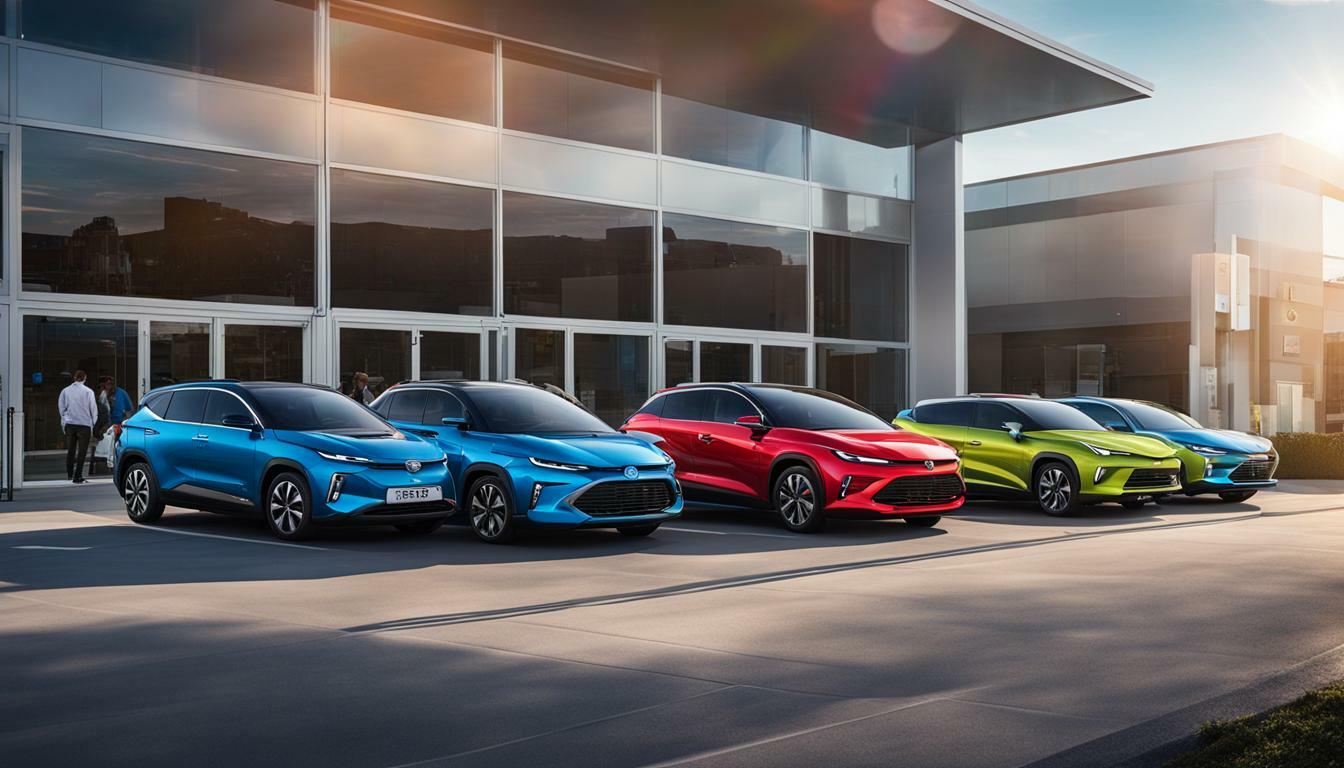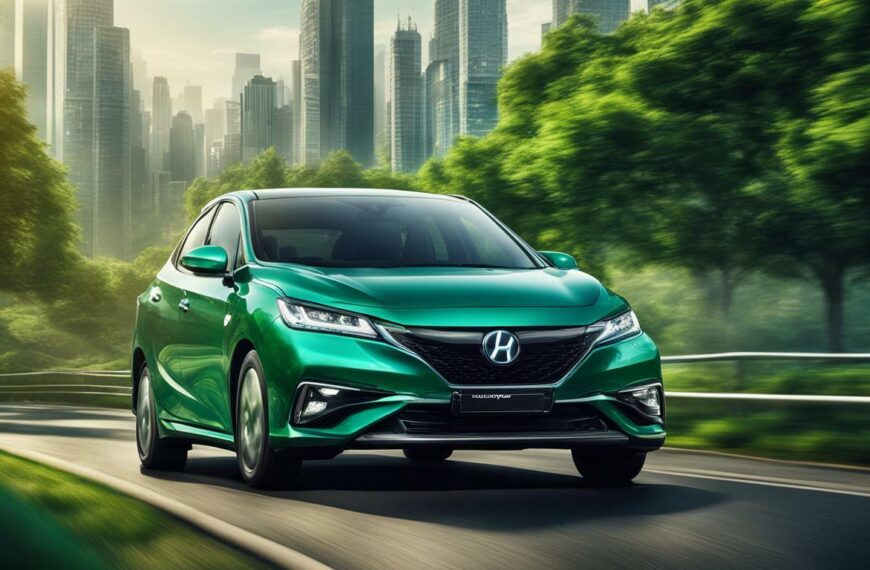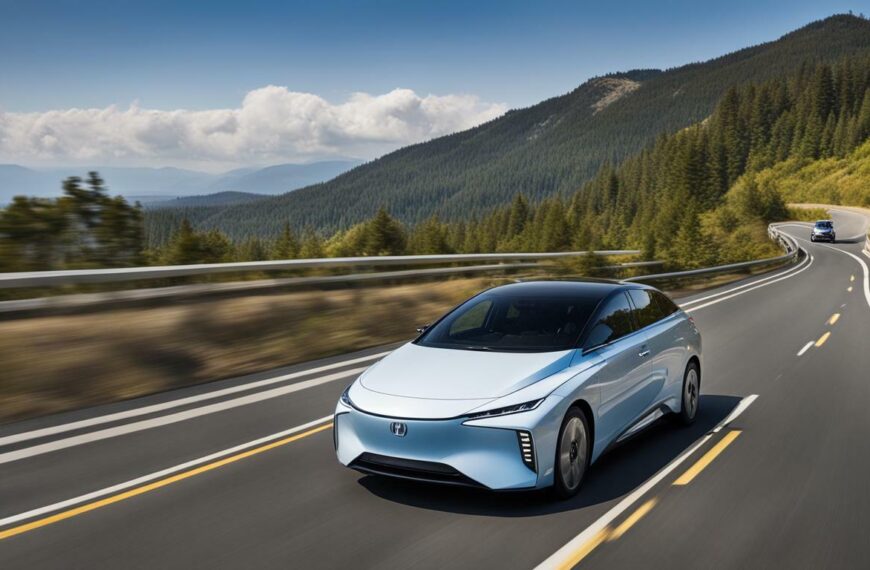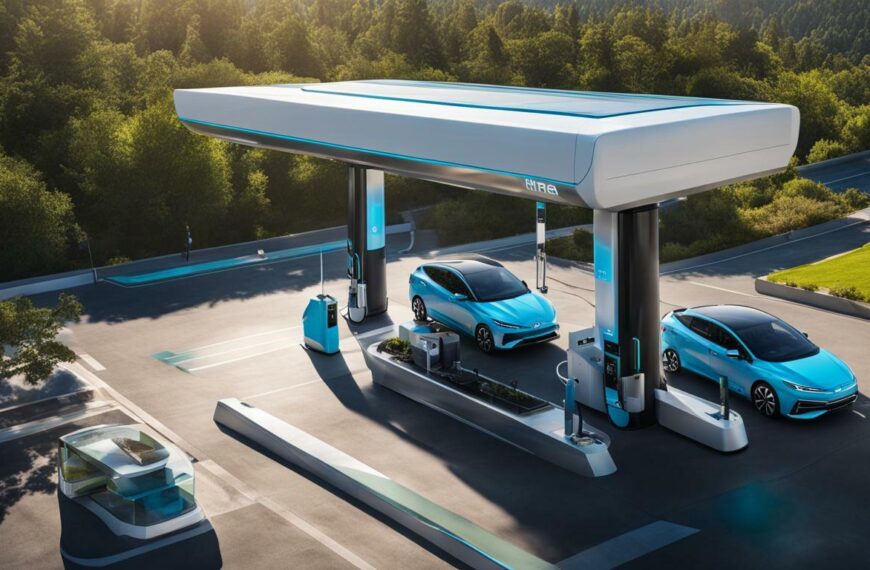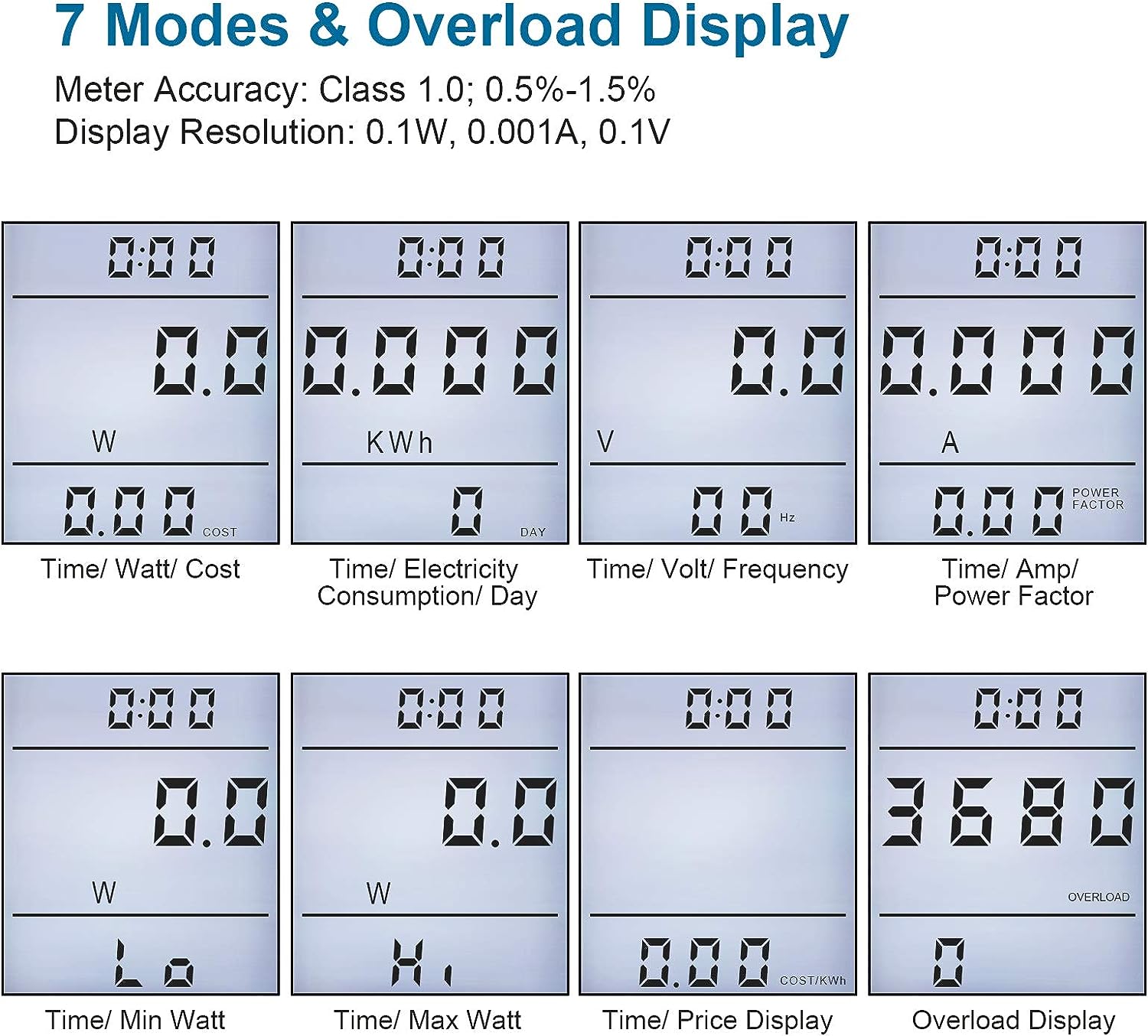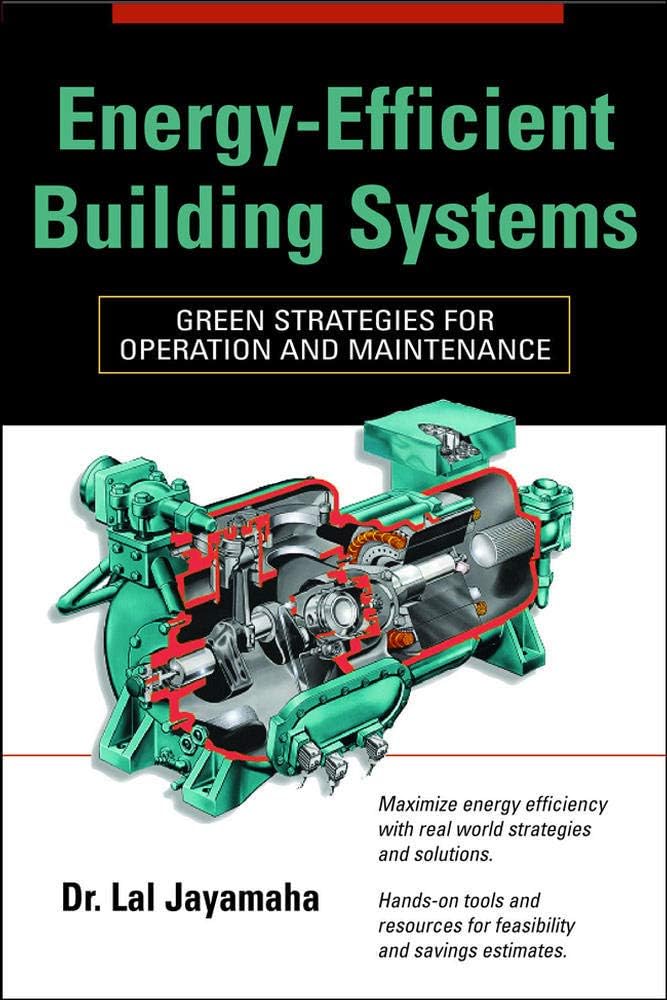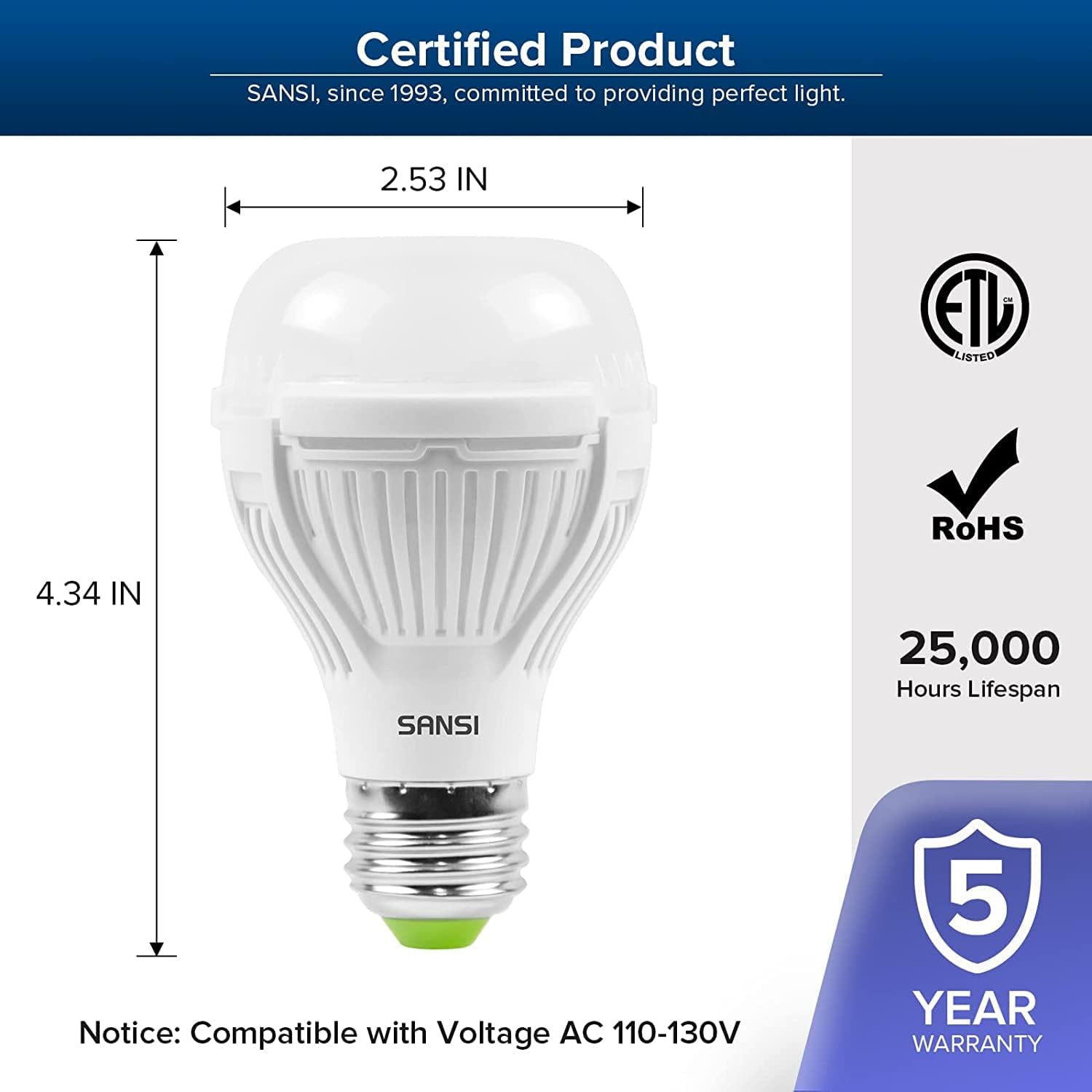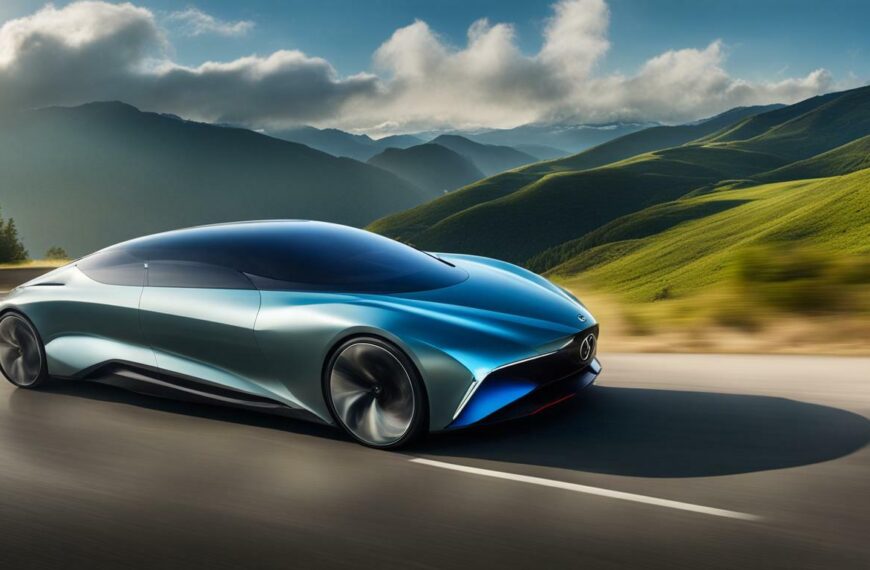Affordable lower cost hydrogen cars are paving the way for a greener and more affordable future of transportation. With the promise of lower costs and eco-friendly features, these vehicles are set to revolutionize the automotive industry. Soon, they will be available in showrooms, giving consumers a budget-friendly option that aligns with their sustainability goals.
Key Takeaways:
- Affordable hydrogen cars are on the horizon, offering consumers a more budget-friendly option for sustainable transportation.
- The Hyundai Nexo, Toyota Mirai, and Honda Clarity Fuel Cell are three hydrogen-powered models currently available, emitting only water vapor.
- The Hyundai Nexo is the first fuel cell vehicle to receive the highest safety rating and offers a spacious interior and electricity generation capabilities.
- The Toyota Mirai boasts a range of 312 miles and quick refueling time, with a bonus of three years or $15,000 worth of free fuel.
- The Honda Clarity Fuel Cell provides a comfortable ride, seating for five people, and a range of 360 miles, but is currently limited to California residents near hydrogen stations.
The Current Landscape of Hydrogen Cars
The current landscape of hydrogen cars offers several economical models that promise both eco-friendliness and cost-effectiveness. With the continuous advancements in technology, hydrogen-powered vehicles are becoming a viable option for environmentally conscious consumers looking for an alternative to traditional gasoline-powered cars.
Currently, there are three hydrogen-powered models available in the market that emit nothing but water vapor. One of these models is the Hyundai Nexo, which is the first fuel cell vehicle to receive the highest safety rating from the Insurance Institute for Highway Safety. The Nexo is an SUV that offers a spacious and practical interior and the ability to generate electricity. It is a testament to the progress being made in the field of hydrogen cars.
“Hydrogen-powered vehicles offer an exciting prospect for the future of transportation. With the current lineup of economical models and their eco-friendly capabilities, it is clear that hydrogen cars are gaining momentum and becoming a viable option for consumers looking to reduce their carbon footprint.”
The Toyota Mirai is another hydrogen-powered car that impresses with its range of 312 miles. It can be refueled in just five minutes, making it convenient for consumers. What’s more, buyers of the Mirai also receive three years or $15,000 worth of free fuel, adding significant value to their purchase.
Lastly, the Honda Clarity Fuel Cell is a hydrogen-powered vehicle that shares its body and interior with the hybrid variant of the Clarity. It offers a comfortable ride, seating for five people, and a range of 360 miles. Although it is currently only available in California for residents living or working in proximity to a hydrogen station, it showcases the commitment of automakers to develop sustainable transportation solutions.
| Hydrogen Car Model | Range | Refueling Time |
|---|---|---|
| Hyundai Nexo | Approximately 380 miles | 5 minutes |
| Toyota Mirai | 312 miles | 5 minutes |
| Honda Clarity Fuel Cell | Approximately 360 miles | Approximately 5 minutes |
While the refueling infrastructure for hydrogen cars is still limited, automakers believe that the technology and infrastructure will expand in the near future. With ongoing research and development efforts, the cost of production is expected to decrease, making hydrogen cars more accessible to a wider range of consumers. As we look towards a greener future, it is essential to continue investing in both technology and infrastructure to overcome the challenges and drive the adoption of affordable and sustainable transportation options.
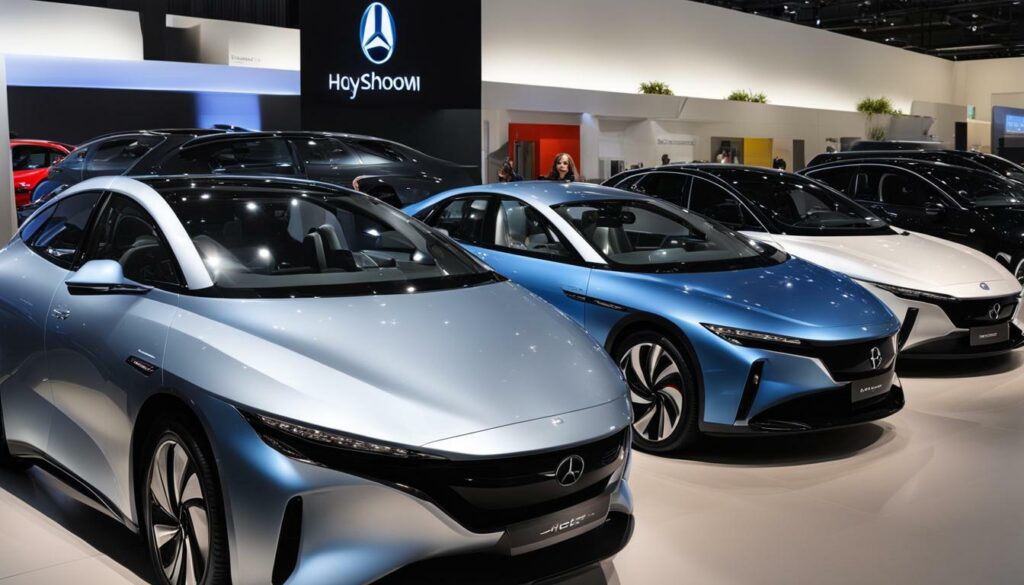
The Hyundai Nexo represents a significant step towards more budget-friendly hydrogen cars, offering both safety and practicality. As the first fuel cell vehicle to receive the highest safety rating from the Insurance Institute for Highway Safety, the Nexo sets a new standard in hydrogen car technology. This SUV not only provides a spacious and practical interior for comfortable rides, but it also boasts the ability to generate electricity, making it a versatile choice for eco-conscious consumers.
With its sleek design and advanced features, the Hyundai Nexo showcases the potential of affordable hydrogen cars. Its innovative fuel cell technology ensures zero-emissions, as the vehicle only emits water vapor. This not only reduces pollution, but also contributes to a greener future. As more consumers seek eco-friendly transportation options, the Nexo offers a compelling choice that aligns with their values and budget.

Furthermore, the Hyundai Nexo provides a glimpse into the future of sustainable transportation at a lower cost. As automakers continue to invest in hydrogen car technology, the Nexo demonstrates their commitment to making these vehicles more accessible to the masses. While the current refueling infrastructure for hydrogen cars is still limited, manufacturers are optimistic that it will expand in the near future, allowing consumers to easily refuel their Nexo and enjoy a seamless driving experience.
In summary, the Hyundai Nexo represents a significant step towards more budget-friendly hydrogen cars. With its safety features, practicality, and eco-friendly performance, the Nexo offers a promising glimpse into the future of sustainable transportation. As automakers continue to innovate and expand the refueling infrastructure, we can look forward to a greener and more affordable future for hydrogen-powered vehicles.
Toyota Mirai: A Range of Possibilities
The Toyota Mirai opens up a range of possibilities with its impressive mileage and convenient refueling options. As a hydrogen-powered vehicle, the Mirai offers a remarkable range of 312 miles, providing drivers with the freedom to travel long distances without worrying about running out of fuel. This makes it a suitable choice for both daily commutes and lengthier journeys.
But what sets the Mirai apart is its quick refueling time of just five minutes. Unlike electric vehicles that require hours to recharge, the Mirai offers a refueling experience similar to that of a conventional gasoline car. This convenience eliminates the range anxiety commonly associated with electric vehicles, making the Mirai a viable option for those who prioritize convenience and ease of use.
The Toyota Mirai is a game-changer in the hydrogen car market. With its impressive range and quick refueling time, it offers a practical solution for those seeking a cost-efficient and eco-friendly vehicle.
Furthermore, Toyota is offering an enticing incentive for potential Mirai owners. When purchasing a Mirai, buyers receive three years or $15,000 worth of free fuel. This not only provides additional savings on fuel costs but also encourages consumers to embrace this innovative technology and experience the benefits themselves.
Overall, the Toyota Mirai represents the future of hydrogen-powered vehicles. Its impressive mileage, convenient refueling options, and attractive incentives make it a compelling choice for those looking to embrace sustainable transportation without compromising on convenience and performance.
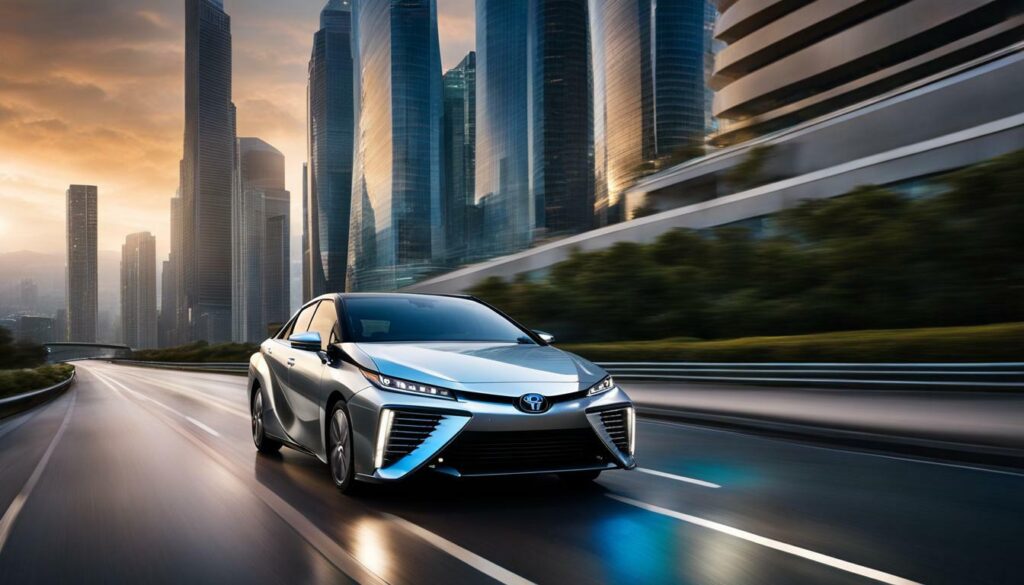
The Honda Clarity Fuel Cell combines comfort and efficiency, offering sustainable transportation at a lower cost. This hydrogen-powered vehicle offers a comfortable ride, spacious seating for five people, and a range of 360 miles. It shares its body and interior with the hybrid variant of the Clarity, showcasing Honda’s commitment to providing eco-friendly options for consumers.
With its impressive range, the Honda Clarity Fuel Cell allows drivers to embark on longer journeys without worrying about refueling. However, it’s important to note that currently, the Clarity Fuel Cell is only available in California for residents living or working near a hydrogen station. This limited availability is due to the current constraints of the refueling infrastructure for hydrogen cars.
To provide further context, let’s take a look at an example of a hydrogen fuel cell vehicle. The image below shows the Honda Clarity Fuel Cell, displaying its sleek design and clean lines. As a zero-emission vehicle, the Clarity Fuel Cell offers an eco-friendly alternative to conventional gasoline-powered cars. Its advanced fuel cell technology converts hydrogen and oxygen into electricity, with water vapor as the only byproduct emitted from the tailpipe.
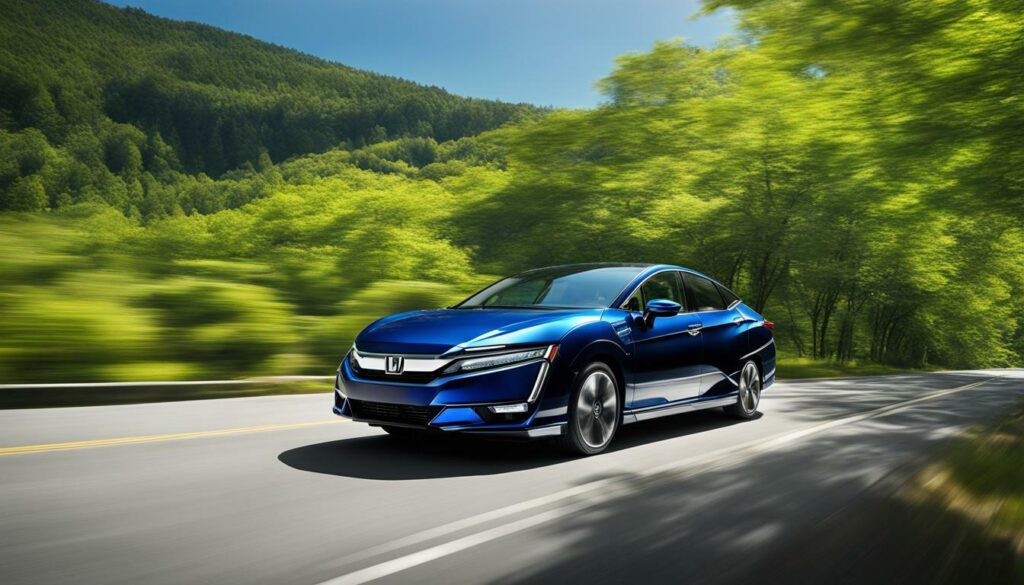
In conclusion, the Honda Clarity Fuel Cell exemplifies Honda’s dedication to combining comfort and efficiency in a sustainable vehicle. While currently limited in availability, the Clarity Fuel Cell offers a glimpse into the future of affordable hydrogen cars. As technology and infrastructure continue to progress, we can look forward to a greener transportation landscape with more accessible and budget-friendly options.
The Limited Refueling Infrastructure
The limited refueling infrastructure poses challenges for hydrogen car owners, impacting the accessibility of these environmentally friendly vehicles. While hydrogen cars offer a promising solution for sustainable transportation, the lack of widespread hydrogen stations makes it difficult for potential buyers to fully embrace this technology.
Currently, the availability of hydrogen stations is limited, with a majority of them concentrated in California. This poses a significant obstacle for residents outside of California who are interested in owning a hydrogen car. Without a sufficient refueling infrastructure, these accessible hydrogen car options remain out of reach for many potential buyers.
The lack of refueling stations also affects the convenience and practicality of owning a hydrogen car. Unlike conventional gasoline-powered vehicles, the refueling process for hydrogen cars takes longer and requires specialized infrastructure. This can be a deterrent for consumers who prioritize convenience and ease of use when choosing a vehicle.
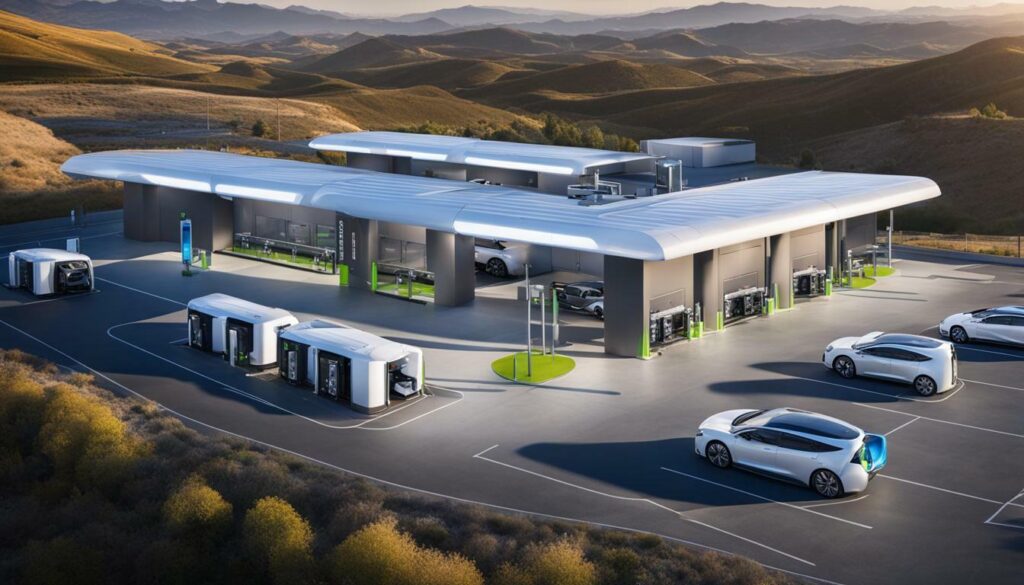
However, automakers and policymakers are working towards expanding the refueling infrastructure for hydrogen cars. With growing interest and demand for sustainable transportation options, there is hope for an increased number of hydrogen stations in the near future. The industry recognizes the need for a comprehensive network of refueling stations to support the wider adoption of hydrogen cars.
As the refueling infrastructure continues to grow, it is crucial for automakers, policymakers, and stakeholders to collaborate and invest in the development of hydrogen stations. By addressing these challenges, we can pave the way for a greener future with accessible hydrogen car options that contribute to sustainable transportation and lower emissions.
The Promise of an Expanded Hydrogen Car Market
The expanding market for hydrogen cars holds great promise for a future of affordable and sustainable transportation. As automakers continue to invest in research and development, we can expect to see advancements in both technology and infrastructure. The current availability of three hydrogen-powered models, such as the Hyundai Nexo, Toyota Mirai, and Honda Clarity Fuel Cell, showcases the potential for lower cost hydrogen cars in the market.
The Hyundai Nexo, for example, has made significant strides in making hydrogen cars more accessible to budget-conscious consumers. Not only is it the first fuel cell vehicle to receive the highest safety rating from the Insurance Institute for Highway Safety, but it also offers a spacious and practical interior. With the ability to generate electricity, the Nexo proves to be a promising option for those looking to embrace sustainable transportation at a lower cost.
Another notable contender is the Toyota Mirai, which boasts an impressive range of 312 miles and a quick refueling time of just five minutes. Buyers of the Mirai also enjoy the bonus of three years or $15,000 worth of free fuel, making it an enticing option for eco-conscious individuals. Additionally, the Honda Clarity Fuel Cell offers a comfortable ride, seating for five people, and a range of 360 miles. While it is currently only available in California for residents near hydrogen stations, its performance and efficiency make it an appealing choice for those seeking sustainable transportation.
| Hydrogen Car Model | Range | Refueling Time | Availability |
|---|---|---|---|
| Hyundai Nexo | Approximately 380 miles | Under 5 minutes | Nationwide availability |
| Toyota Mirai | Approximately 312 miles | Under 5 minutes | Nationwide availability |
| Honda Clarity Fuel Cell | Approximately 360 miles | Under 5 minutes | Currently available in California for residents near hydrogen stations |
Despite the current limitations in refueling infrastructure, automakers remain optimistic about the future of affordable hydrogen vehicles. They believe that as technology advances and the demand for sustainable transportation grows, the infrastructure for hydrogen cars will expand. With continued investment in technology, infrastructure, and public awareness, the vision of a greener future with lower cost hydrogen cars is within reach.
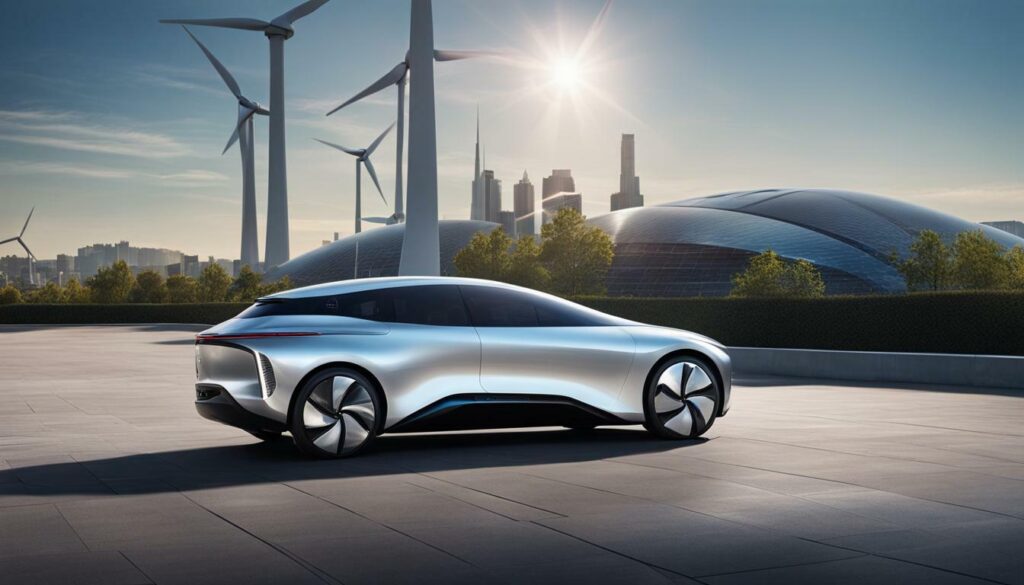
Lower cost hydrogen cars bring a range of benefits to budget-conscious consumers, offering eco-friendly driving without breaking the bank. As more affordable options become available in the market, these economical hydrogen car models provide an environmentally-conscious alternative to traditional gasoline-powered vehicles. With zero harmful emissions and the ability to generate electricity, hydrogen cars contribute to sustainable transportation while offering a practical and efficient mode of travel.
One such hydrogen-powered car is the Hyundai Nexo, the first fuel cell vehicle to receive the highest safety rating from the Insurance Institute for Highway Safety. This SUV not only offers a spacious and practical interior, but it also provides peace of mind for safety-conscious buyers. By choosing the Hyundai Nexo, budget-conscious consumers can enjoy the benefits of a lower cost hydrogen car without compromising on safety or style.
“Lower cost hydrogen cars bring a range of benefits to budget-conscious consumers, offering eco-friendly driving without breaking the bank.”
Another option for those looking for cost-efficient hydrogen-powered vehicles is the Toyota Mirai. With a range of 312 miles and a quick refueling time of just five minutes, the Mirai offers convenience and practicality for everyday use. In addition to these features, buyers of the Mirai also receive the bonus of three years or $15,000 worth of free fuel, further adding to the affordability of this hydrogen car model.
For those interested in both comfort and efficiency, the Honda Clarity Fuel Cell is an excellent choice. With its shared body and interior with the Clarity hybrid variant, this hydrogen-powered vehicle offers a comfortable ride for up to five people. With a range of 360 miles, it provides the versatility required for long journeys. However, it is important to note that the Honda Clarity Fuel Cell is currently only available in California for residents living or working in the proximity to a hydrogen station.
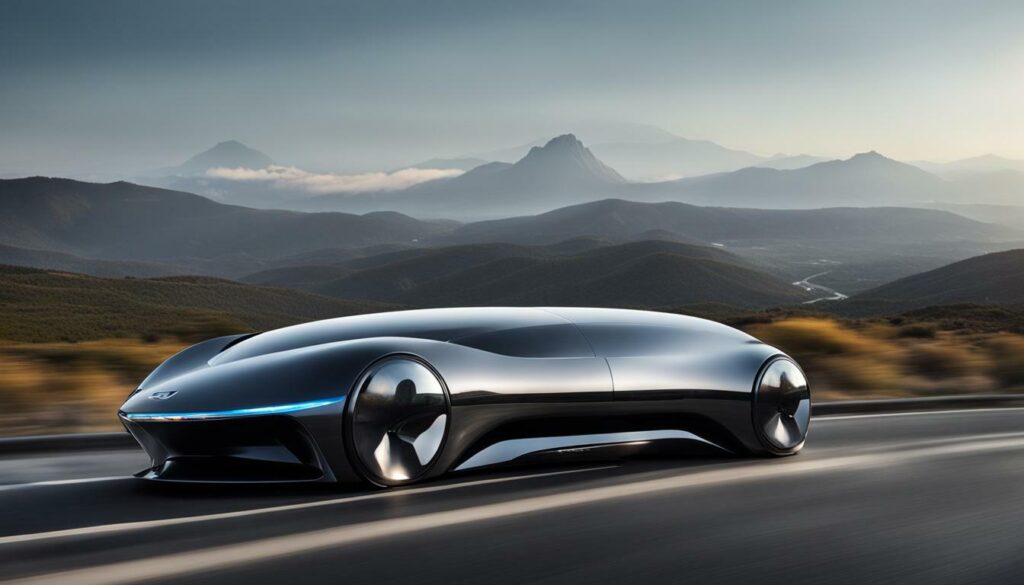
In conclusion, lower cost hydrogen cars offer a variety of benefits to budget-conscious consumers. With their eco-friendly nature, affordable pricing, and features that rival traditional vehicles, these hydrogen car models provide a sustainable and cost-efficient solution for transportation needs. While challenges such as limited refueling infrastructure still exist, the growing market for hydrogen cars and the commitment of automakers towards technological advancements and infrastructure expansion point towards a future where affordable and eco-friendly transportation is within reach for all.
Overcoming Challenges for a Greener Future
Achieving a greener future with lower cost hydrogen cars requires overcoming various challenges through consistent investment and policy support. While the current landscape of hydrogen vehicles shows promise, there are obstacles that need to be addressed to fully realize their potential.
One of the primary challenges is the limited refueling infrastructure for hydrogen cars. Although hydrogen stations exist, their availability is currently limited, primarily to areas like California. This poses challenges for residents outside these regions who may be interested in owning a hydrogen car. However, automakers remain optimistic that the infrastructure will expand in the near future, enabling wider adoption of hydrogen vehicles.
Another challenge lies in the need for continued investment in technology and research. Lowering the production costs of hydrogen cars and improving their efficiency are crucial factors in making them more accessible and affordable for consumers. Ongoing research and development efforts are focused on finding innovative solutions to address these challenges and make hydrogen cars a viable option for a larger consumer base.
| Challenges | Solutions |
|---|---|
| Limited refueling infrastructure | Expansion of hydrogen stations to increase accessibility |
| High production costs | Investment in technology and research to reduce costs |
| Improving efficiency | Ongoing research and development efforts |
Furthermore, policy support from governments and regulatory bodies is essential for the growth and adoption of hydrogen cars. Policies that incentivize the purchase of hydrogen vehicles and the development of refueling infrastructure can encourage consumers and businesses to transition to more sustainable transportation options. This support can significantly contribute to the overall viability and success of lower cost hydrogen cars.
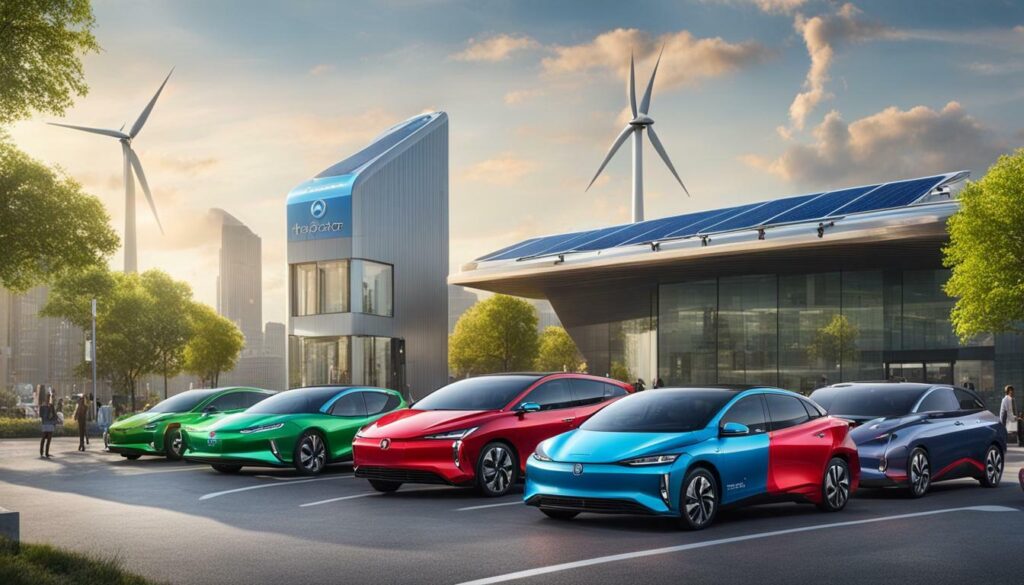
While there are challenges to overcome, the future of affordable and eco-friendly hydrogen vehicles is promising. With continued investment, policy support, and advancements in technology, hydrogen cars have the potential to revolutionize sustainable transportation at a lower cost. As the industry continues to evolve and expand, it is crucial for consumers, automakers, and policymakers to work together to create a greener and more sustainable future.
The Role of Consumers in Driving Change
Budget-conscious consumers have the power to drive change towards sustainable transportation at a lower cost by embracing hydrogen cars. With the increasing availability of affordable hydrogen car models in the market, consumers now have the opportunity to make a positive impact on the environment while also saving on fuel costs. By choosing hydrogen cars, consumers can contribute to a greener future and support the growth of this promising technology.
One of the key advantages of hydrogen cars for budget-conscious consumers is the potential for long-term savings on fuel costs. Hydrogen fuel is more cost-efficient compared to gasoline, and over time, this can result in significant savings for consumers. Additionally, hydrogen cars produce zero emissions, making them an eco-friendly alternative to traditional gasoline-powered vehicles. By driving a hydrogen car, consumers can reduce their carbon footprint and contribute to cleaner air and healthier communities.
Moreover, by embracing hydrogen cars, consumers are sending a strong signal to automakers and policymakers about the demand for sustainable transportation options. As more consumers choose hydrogen cars, automakers will be encouraged to invest in research and development to improve the technology and reduce production costs. Increased demand will also drive the expansion of hydrogen refueling infrastructure, making it more accessible for consumers outside of California.
How Consumers Can Make a Difference
- Research and educate themselves about the benefits and features of hydrogen cars
- Visit showrooms and test drive hydrogen car models to experience the benefits first-hand
- Advocate for increased investment in hydrogen refueling infrastructure in their local communities
- Spread awareness about hydrogen cars through word of mouth and social media
- Participate in local and national initiatives that promote sustainable transportation
By actively engaging in these actions, budget-conscious consumers can play a crucial role in driving the transition towards sustainable transportation at a lower cost. As the hydrogen car market continues to grow, consumers have the opportunity to shape the future of transportation and contribute to a greener and more affordable world.
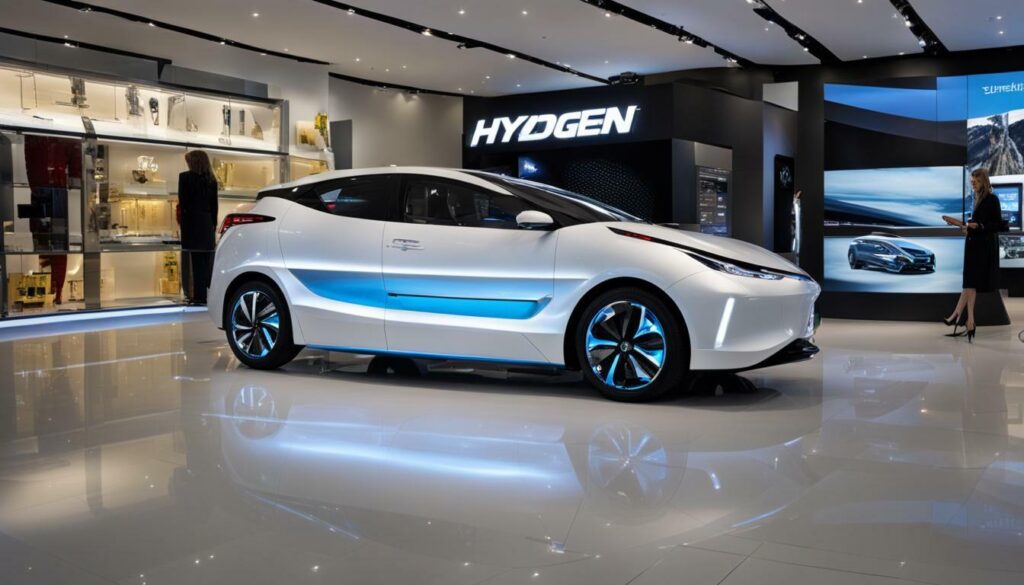
The future of affordable hydrogen vehicles is bright, with ongoing efforts to make these cost-efficient and eco-friendly cars a reality. Automakers are investing heavily in research and development to reduce production costs and improve the efficiency of hydrogen-powered vehicles. As a result, consumers can look forward to a wider range of affordable options in the near future.
One of the key advantages of hydrogen cars is their superior range compared to electric vehicles. The Toyota Mirai, for example, offers a range of 312 miles on a full tank of hydrogen, allowing for longer trips without the need for frequent refueling. This range, coupled with a quick refueling time of just five minutes, makes hydrogen cars a convenient choice for consumers.
Additionally, automakers are offering incentives to further enhance the affordability of hydrogen vehicles. For instance, buyers of the Toyota Mirai receive three years or $15,000 worth of free fuel, reducing the running costs and making these cars even more cost-efficient. Such offers make hydrogen cars an attractive option for budget-conscious consumers looking for sustainable transportation.
| Hydrogen Car Model | Range | Refueling Time |
|---|---|---|
| Toyota Mirai | 312 miles | 5 minutes |
| Honda Clarity Fuel Cell | 360 miles | N/A* |
While the availability of hydrogen refueling stations is still limited, automakers and governments alike are committed to expanding the infrastructure. As more hydrogen stations are established, the accessibility of hydrogen cars will improve, allowing consumers outside of California to benefit from this eco-friendly transportation option.
In summary, the future of affordable hydrogen vehicles looks promising. Ongoing efforts to enhance the cost-efficiency and eco-friendliness of these cars are driving positive change in the industry. With a wider range of affordable options, improved infrastructure, and incentives from automakers, hydrogen cars have the potential to revolutionize sustainable transportation, providing a greener and more affordable future for all.
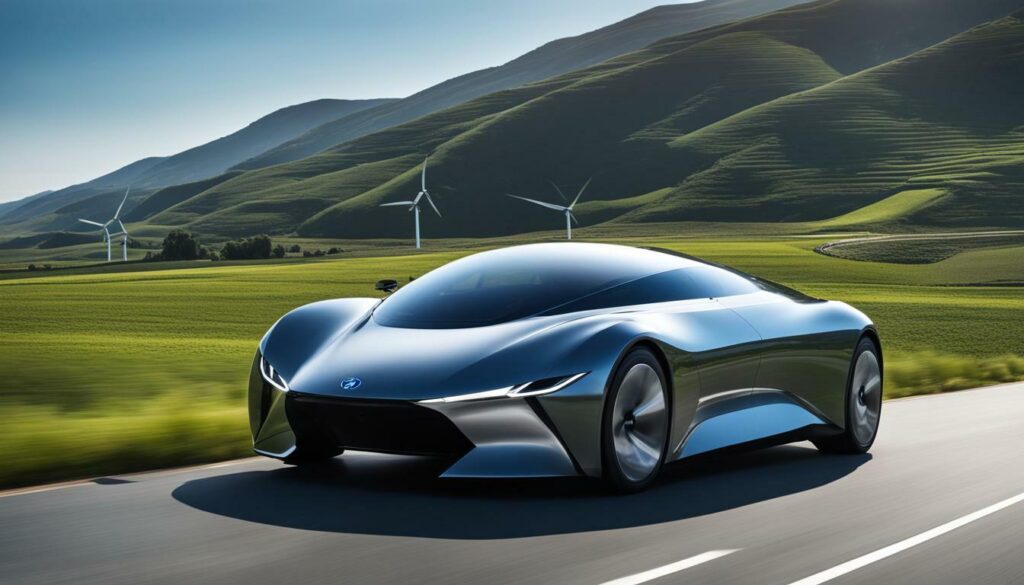
Lower cost hydrogen cars offer a glimpse into a future where sustainable transportation is more accessible and affordable, paving the way for a greener and cleaner world. With the introduction of hydrogen-powered vehicles like the Hyundai Nexo, Toyota Mirai, and Honda Clarity Fuel Cell, consumers now have more options when it comes to environmentally-friendly transportation.
The Hyundai Nexo, the first fuel cell vehicle to receive the highest safety rating from the Insurance Institute for Highway Safety, provides a practical and spacious SUV option. Not only does it offer a comfortable and eco-friendly ride, but it also has the ability to generate electricity.
The Toyota Mirai, with its impressive range of 312 miles and quick refueling time of just five minutes, offers convenience to its users. Additionally, the bonus of three years or $15,000 worth of free fuel is an attractive incentive for those looking to make the switch to hydrogen-powered vehicles.
While the Honda Clarity Fuel Cell shares its body and interior with the hybrid variant of the Clarity, it offers a comfortable ride with seating for five people and a range of 360 miles. However, it is currently limited to residents of California who live or work near a hydrogen station.
Although the refueling infrastructure for hydrogen cars is still limited, automakers are optimistic about the future expansion of both technology and infrastructure. Continued investment in research and development, as well as public awareness, will be crucial in overcoming the challenges and driving the growth of hydrogen-powered vehicles.
As consumers, we have the power to make a difference by considering the environmental and economical benefits of hydrogen cars. The demand for these vehicles will play a crucial role in pushing for further advancements in the industry and shaping a future where sustainable transportation is more accessible and affordable for all.
FAQ
Are hydrogen cars more affordable than traditional gasoline-powered cars?
While hydrogen cars currently have a higher upfront cost, the long-term savings in fuel costs and potential incentives can make them more affordable for certain consumers.
How far can hydrogen cars travel on one tank?
The range of hydrogen cars varies depending on the model. For example, the Toyota Mirai has a range of 312 miles, while the Honda Clarity Fuel Cell can travel up to 360 miles on one tank.
How long does it take to refuel a hydrogen car?
Refueling a hydrogen car can be done in as little as five minutes, similar to the time it takes to refuel a gasoline-powered car.
Are there any incentives or benefits for purchasing a hydrogen car?
Some manufacturers offer incentives for purchasing a hydrogen car, such as free fuel for a certain period of time or a specific dollar amount. Additionally, there may be tax credits or other government incentives available depending on your location.
Where can I refuel my hydrogen car?
Currently, the refueling infrastructure for hydrogen cars is limited, with hydrogen stations primarily located in California. However, automakers are actively working on expanding the infrastructure to make refueling more accessible.
Are there any environmental benefits to owning a hydrogen car?
Yes, hydrogen cars are considered environmentally friendly as they emit only water vapor. They contribute to reducing greenhouse gas emissions and help promote sustainable transportation.
Can I use a hydrogen car for long road trips?
The range of hydrogen cars, such as the Toyota Mirai and Honda Clarity Fuel Cell, makes them suitable for long road trips. However, it is important to plan your route to ensure access to hydrogen stations along the way.
Are hydrogen cars safe?
Yes, hydrogen cars undergo rigorous safety testing and are equipped with advanced safety features. The Hyundai Nexo, for example, has received the highest safety rating from the Insurance Institute for Highway Safety.
Can I use hydrogen fuel cells to power my home?
While hydrogen fuel cells have the potential to be used for residential power generation, the technology is still in development. Currently, fuel cells are primarily used to power vehicles.
How can I support the growth of hydrogen cars?
You can support the growth of hydrogen cars by considering them as a viable option for your next vehicle purchase. Increased demand for hydrogen cars will drive further advancements in the industry and help expand the refueling infrastructure.
